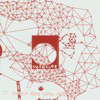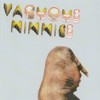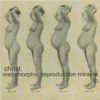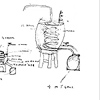Synaesthesia
 Subtlety can either add to a composition or take away from it. Ifunderstatement is enough to carry a tune then there's no reason to addanything to it. It Would Have Lived Hereis a very careful album and ends up benefitting for it. Everything isbare bones and this approach works very well. Most of the tones usedare metallic in nature and percussive but more often than not there areless musical and more found-sound effects used. Everything beginsrather enigmatically: there is rhythm, but it heeds to no timesignature. There is a bass-like strumming throughout and the sound oftiny cymbals chiming everywhere, but no melody to speak of. Randomsounds bounce back and forth between my ears and now and again there'sa quick stab of recognizable speech but it's distant. Metallic soundsrun throughout this full-length but in different forms. Some are usedto create short melodic lines, others produce a constant backgroundnoise that ties the various tracks together in different ways, andothers simply pop in and out of the music like images of killing yourboss during a hectic day of work. Nothing ever jumps out and grabs myattention immediately. Every moment is saturated with interestingsounds that stretch, echo, and breathe without interference. The sensethat the sounds are somehow coming from a living, breathing thing isstrong and a bit unsettling at times. Snawklor obviously pay closeattention to detail and the result of their patience is nothing shortof beautiful. Despite its rather abstract nature it is highlyaccessible and fun to listen to.
Subtlety can either add to a composition or take away from it. Ifunderstatement is enough to carry a tune then there's no reason to addanything to it. It Would Have Lived Hereis a very careful album and ends up benefitting for it. Everything isbare bones and this approach works very well. Most of the tones usedare metallic in nature and percussive but more often than not there areless musical and more found-sound effects used. Everything beginsrather enigmatically: there is rhythm, but it heeds to no timesignature. There is a bass-like strumming throughout and the sound oftiny cymbals chiming everywhere, but no melody to speak of. Randomsounds bounce back and forth between my ears and now and again there'sa quick stab of recognizable speech but it's distant. Metallic soundsrun throughout this full-length but in different forms. Some are usedto create short melodic lines, others produce a constant backgroundnoise that ties the various tracks together in different ways, andothers simply pop in and out of the music like images of killing yourboss during a hectic day of work. Nothing ever jumps out and grabs myattention immediately. Every moment is saturated with interestingsounds that stretch, echo, and breathe without interference. The sensethat the sounds are somehow coming from a living, breathing thing isstrong and a bit unsettling at times. Snawklor obviously pay closeattention to detail and the result of their patience is nothing shortof beautiful. Despite its rather abstract nature it is highlyaccessible and fun to listen to.
 Subtlety can either add to a composition or take away from it. Ifunderstatement is enough to carry a tune then there's no reason to addanything to it. It Would Have Lived Hereis a very careful album and ends up benefitting for it. Everything isbare bones and this approach works very well. Most of the tones usedare metallic in nature and percussive but more often than not there areless musical and more found-sound effects used. Everything beginsrather enigmatically: there is rhythm, but it heeds to no timesignature. There is a bass-like strumming throughout and the sound oftiny cymbals chiming everywhere, but no melody to speak of. Randomsounds bounce back and forth between my ears and now and again there'sa quick stab of recognizable speech but it's distant. Metallic soundsrun throughout this full-length but in different forms. Some are usedto create short melodic lines, others produce a constant backgroundnoise that ties the various tracks together in different ways, andothers simply pop in and out of the music like images of killing yourboss during a hectic day of work. Nothing ever jumps out and grabs myattention immediately. Every moment is saturated with interestingsounds that stretch, echo, and breathe without interference. The sensethat the sounds are somehow coming from a living, breathing thing isstrong and a bit unsettling at times. Snawklor obviously pay closeattention to detail and the result of their patience is nothing shortof beautiful. Despite its rather abstract nature it is highlyaccessible and fun to listen to.
Subtlety can either add to a composition or take away from it. Ifunderstatement is enough to carry a tune then there's no reason to addanything to it. It Would Have Lived Hereis a very careful album and ends up benefitting for it. Everything isbare bones and this approach works very well. Most of the tones usedare metallic in nature and percussive but more often than not there areless musical and more found-sound effects used. Everything beginsrather enigmatically: there is rhythm, but it heeds to no timesignature. There is a bass-like strumming throughout and the sound oftiny cymbals chiming everywhere, but no melody to speak of. Randomsounds bounce back and forth between my ears and now and again there'sa quick stab of recognizable speech but it's distant. Metallic soundsrun throughout this full-length but in different forms. Some are usedto create short melodic lines, others produce a constant backgroundnoise that ties the various tracks together in different ways, andothers simply pop in and out of the music like images of killing yourboss during a hectic day of work. Nothing ever jumps out and grabs myattention immediately. Every moment is saturated with interestingsounds that stretch, echo, and breathe without interference. The sensethat the sounds are somehow coming from a living, breathing thing isstrong and a bit unsettling at times. Snawklor obviously pay closeattention to detail and the result of their patience is nothing shortof beautiful. Despite its rather abstract nature it is highlyaccessible and fun to listen to.

 On Frankie Sparo's last full-length, My Red Scare,he created his own brand of chilling folk mostly on his lonesome withthe help of some friends and labelmates. Now his group has grown to afull-fledged and powerful duo with the addition of Nadia Moss on anyinstrument with keys. He's also brought along some old friends from ASilver Mt. Zion: Sophie, Thierry and Efrim all play on the album withthe latter also handling recording duties at Hotel2Tango. The result isa growth from the previous record while retaining the same qualitiesthat made Sparo so engaging in the first place. Welcome Crummy Mystics is also a jarring, hair-raising listen, as the new orchestral direction Sparo started on Arena Hostilesees fruition with new original compositions that explore differentrhythms and musical forms. Odd sounds captured here and there make theheart jump, as does Sparo's voice and delivery. "Hospitalville"features compression effects that scatter and depurify the drums andSparo's vocals. He does it himself on "Back on Speed," screaming andletting his voice buckle under the pressure, backed at the end by abizarre choir. The minimalism of the past is still present on a fewsongs, such as "Sleds to Moderne" and "Bright Angel Park," but thearrangements and contributions of the guest musicians give the musicand performance amazing depth. The addition of Moss cannot beunderstated, however, as it is her instrumentation that is the mostvital, that separates these structures from others in the genre like somuch musical three-point lighting. Together, she and Frankie Sparo areforming a new language that they want to teach the world. It soundsgreat so far, and there's nothing lost in the translation. -
On Frankie Sparo's last full-length, My Red Scare,he created his own brand of chilling folk mostly on his lonesome withthe help of some friends and labelmates. Now his group has grown to afull-fledged and powerful duo with the addition of Nadia Moss on anyinstrument with keys. He's also brought along some old friends from ASilver Mt. Zion: Sophie, Thierry and Efrim all play on the album withthe latter also handling recording duties at Hotel2Tango. The result isa growth from the previous record while retaining the same qualitiesthat made Sparo so engaging in the first place. Welcome Crummy Mystics is also a jarring, hair-raising listen, as the new orchestral direction Sparo started on Arena Hostilesees fruition with new original compositions that explore differentrhythms and musical forms. Odd sounds captured here and there make theheart jump, as does Sparo's voice and delivery. "Hospitalville"features compression effects that scatter and depurify the drums andSparo's vocals. He does it himself on "Back on Speed," screaming andletting his voice buckle under the pressure, backed at the end by abizarre choir. The minimalism of the past is still present on a fewsongs, such as "Sleds to Moderne" and "Bright Angel Park," but thearrangements and contributions of the guest musicians give the musicand performance amazing depth. The addition of Moss cannot beunderstated, however, as it is her instrumentation that is the mostvital, that separates these structures from others in the genre like somuch musical three-point lighting. Together, she and Frankie Sparo areforming a new language that they want to teach the world. It soundsgreat so far, and there's nothing lost in the translation. -  Hang a fat chick in a sequin jumpsuit from the ceiling and break outthe cocaine. The beats are fat, the melodies are slick, and theinstrumentation is a biological mass of boogiemania. Vacuous Ninnies'self-titled party-on-a-CD is an accumulation of strange sounds that arecut, pasted, manipulated, and arranged into either dancey fireballs orultra cool chillouts. What's interesting is that none of that fluffyand yuppy-like smooth production is employed nor are any minimalistictendencies revealed. The samples are robust and lively and mixed intobeautiful melodies and chugging beats. Although "Cripples Fall Down"opens the album, it's the fun-machine known as "(Can't) Get Up" thatreally kicks things off. It's full of dissected vocal samples, glidingsynthesizers that cut the air like a jet of pure 80's soul and arumptastic, rubbery beat. The slower songs have a more wondering feelabout them: there isn't always a fixed melody and the beat isn't alwaysexplosive but the effect is gentle and ravishing. There's a sense ofhumor throughout this full-length, too. Some of the samples used areabsolutely whacky and at times a bit psychadelic. None of the music hasa serious or "arty" attitude. The sounds don't always glide togetherflawlessly and as a result the melodies can sound just slightlyout-of-control or off-center. Why bother "perfecting" something likethis when it sounds so exceptional in a wild and untamed state? I getthe distinct impression that whoever the Vacuous Ninnies are, they hada whole lot of fun making this.
Hang a fat chick in a sequin jumpsuit from the ceiling and break outthe cocaine. The beats are fat, the melodies are slick, and theinstrumentation is a biological mass of boogiemania. Vacuous Ninnies'self-titled party-on-a-CD is an accumulation of strange sounds that arecut, pasted, manipulated, and arranged into either dancey fireballs orultra cool chillouts. What's interesting is that none of that fluffyand yuppy-like smooth production is employed nor are any minimalistictendencies revealed. The samples are robust and lively and mixed intobeautiful melodies and chugging beats. Although "Cripples Fall Down"opens the album, it's the fun-machine known as "(Can't) Get Up" thatreally kicks things off. It's full of dissected vocal samples, glidingsynthesizers that cut the air like a jet of pure 80's soul and arumptastic, rubbery beat. The slower songs have a more wondering feelabout them: there isn't always a fixed melody and the beat isn't alwaysexplosive but the effect is gentle and ravishing. There's a sense ofhumor throughout this full-length, too. Some of the samples used areabsolutely whacky and at times a bit psychadelic. None of the music hasa serious or "arty" attitude. The sounds don't always glide togetherflawlessly and as a result the melodies can sound just slightlyout-of-control or off-center. Why bother "perfecting" something likethis when it sounds so exceptional in a wild and untamed state? I getthe distinct impression that whoever the Vacuous Ninnies are, they hada whole lot of fun making this.  The much anticipated synthesized sexual symphony of Hecate's RachaelKozak and Venetian Snares' Aaron Funk is quite clinical in its finalstate. Created entirely from sounds of the two's sexcapades in variousplaces on their tour, the music is more appealing in the creationconcept. What's left at the end are the thumps of bed posts as bassdrum kicks, loads of high-pitched rhythmic sounds and only a tinysplash of bedroom banter. The second cut (or first non-filler song ifyou discount the Intro) "Blood on the Rope" gives a lot of hope withsome heavy breathing and some skin slapping sounds towards thebeginning, but it shortly gives way to moderately unchallengingmechanic dark drum 'n bass. The two deserve credit for assembling 35minutes of music which rarely resemble the original sources, butthere's something to be said for a stronger incorporation of untouchedrecordings back in to the mix once things have become unrecognizable.After being in love with the previous two brilliant EPs from VenetianSnares on Hymen, the Nymphomatriarch is musically a let-down as itdoesn't even seem as provocative or daring as either nor as the hypewould make it seem. Fans of clean drum 'n bass sounds might feelslightly different, however, and with about 12 minutes of underwaterambience smack-dab in the middle, those who can only read about sexmight find a charge. The closest this extended single comes to orgasmicis in the second to last track (or last non-filler track) "Pervs,"where more skin slapping could be taking place, but it's so far removedfrom recognition that it could easily be just another clever computerplugin. Perhaps I'm too much of a sick pervert, myself, but I think Iwas truly jonesing for a more voyeuristic and unlubricated experience,one where the sound could conjure the smells of the breath and fluidsof everybody involved.
The much anticipated synthesized sexual symphony of Hecate's RachaelKozak and Venetian Snares' Aaron Funk is quite clinical in its finalstate. Created entirely from sounds of the two's sexcapades in variousplaces on their tour, the music is more appealing in the creationconcept. What's left at the end are the thumps of bed posts as bassdrum kicks, loads of high-pitched rhythmic sounds and only a tinysplash of bedroom banter. The second cut (or first non-filler song ifyou discount the Intro) "Blood on the Rope" gives a lot of hope withsome heavy breathing and some skin slapping sounds towards thebeginning, but it shortly gives way to moderately unchallengingmechanic dark drum 'n bass. The two deserve credit for assembling 35minutes of music which rarely resemble the original sources, butthere's something to be said for a stronger incorporation of untouchedrecordings back in to the mix once things have become unrecognizable.After being in love with the previous two brilliant EPs from VenetianSnares on Hymen, the Nymphomatriarch is musically a let-down as itdoesn't even seem as provocative or daring as either nor as the hypewould make it seem. Fans of clean drum 'n bass sounds might feelslightly different, however, and with about 12 minutes of underwaterambience smack-dab in the middle, those who can only read about sexmight find a charge. The closest this extended single comes to orgasmicis in the second to last track (or last non-filler track) "Pervs,"where more skin slapping could be taking place, but it's so far removedfrom recognition that it could easily be just another clever computerplugin. Perhaps I'm too much of a sick pervert, myself, but I think Iwas truly jonesing for a more voyeuristic and unlubricated experience,one where the sound could conjure the smells of the breath and fluidsof everybody involved.  Christ's first full-length album is a dubby and thick pudding of scarydreams and rainbow-filled landscapes. Christ has been compared toBoards of Canada before, but I think it would be a mistake to leave adescription of Metamorphic Reproduction Miracleat that. The songs walk a fine line between static repetition andirregular activity. Keyboards will chime and gurgle while a solidrhythm runs around in circles in the background; they are inseperablefrom eachother and the effect of one relies on the effect of the other.As a result the music often feels like a blob slowly oozing its way upmy body. There are plenty of detuned tones and happy melodies, butthere is an added element (mostly in the early tracks) of horror, too."Lazy Daisy Meadow" features a sizzling electronic voice sufferingunder an overcast of humming clouds and "Dianoes Nouveau" is abrilliant dub-influenced piece armed to the teeth with anxiety,apprehension, and a stunning arrangement that coheres into a mass ofbeautiful melody. The manner in which Christ arranges his instrumentsis confusing at first. The music has movement and there's an element ofhip-hop in some songs, but often there's a feeling as if the music isonly producing the illusion of movement. The quality of the entirealbum is very organic and gooey. Metamorphic is neitherentirely dark nor wholly joyous; instead it strikes a nice balancebetween the two extremes that makes it listenable at about any time.I'd like to hear more from Christ, especially something focused on thesound exposed in "Dianoes Nouveau." Eventually the goo dries up and bythe time "School Is Not Compulsory" fades away I'm left feeling alittle teased. The same thing that makes the early part of this albumgreat ends up making the last part feel a bit drawn out: a little morevariation and breath outside the blob would certainly be nice.
Christ's first full-length album is a dubby and thick pudding of scarydreams and rainbow-filled landscapes. Christ has been compared toBoards of Canada before, but I think it would be a mistake to leave adescription of Metamorphic Reproduction Miracleat that. The songs walk a fine line between static repetition andirregular activity. Keyboards will chime and gurgle while a solidrhythm runs around in circles in the background; they are inseperablefrom eachother and the effect of one relies on the effect of the other.As a result the music often feels like a blob slowly oozing its way upmy body. There are plenty of detuned tones and happy melodies, butthere is an added element (mostly in the early tracks) of horror, too."Lazy Daisy Meadow" features a sizzling electronic voice sufferingunder an overcast of humming clouds and "Dianoes Nouveau" is abrilliant dub-influenced piece armed to the teeth with anxiety,apprehension, and a stunning arrangement that coheres into a mass ofbeautiful melody. The manner in which Christ arranges his instrumentsis confusing at first. The music has movement and there's an element ofhip-hop in some songs, but often there's a feeling as if the music isonly producing the illusion of movement. The quality of the entirealbum is very organic and gooey. Metamorphic is neitherentirely dark nor wholly joyous; instead it strikes a nice balancebetween the two extremes that makes it listenable at about any time.I'd like to hear more from Christ, especially something focused on thesound exposed in "Dianoes Nouveau." Eventually the goo dries up and bythe time "School Is Not Compulsory" fades away I'm left feeling alittle teased. The same thing that makes the early part of this albumgreat ends up making the last part feel a bit drawn out: a little morevariation and breath outside the blob would certainly be nice. Then there's that scene in the Wizard of Oz where the hurricane comesknocking on the door and there's no stopping it. Sightings latest albumopens with the sound of the scenes that would have been cut from thefilm for being too graphically violent. There's a mess of nature at thedoor and it's ready to explode itself on everybody inside, blasting allwith a violent barrage of dirt, water, debris and a tractor orsomething. It's impossible to shut the door, it's impossible to escape,and nothing is safe in its path. There's only a few points where theattack becomes less violent, like by the third track, "Anna Mae Wang,"which, at its calmest, sounds like a busy construction site. But, theparty starts back up again with the closest Sightings will ever come toa funky post-punk dancefloor smash, "Bishops," and continues with theequally dancey "Canadian Money." The second half is certainly a morebody friendly as songs like "Right Side of the Hall" could be an homageto the violent techno of earlier Panacea days while the closer,"Reduction" could pass for Liquid Liquid or A Certain Ratio put througha distorted Sightings-designed noise filter. Make no mistake about it:there's nothing accidental about their sound, as the trio full aware ofthe potential of gear and the ability to make everything moreblistering and sweaty without making it sound like a crackpot crew ofamateurs. It makes me proud to live in such a wonderful time whenrockers and noisemongers can live in ear bleeding disharmony.
Then there's that scene in the Wizard of Oz where the hurricane comesknocking on the door and there's no stopping it. Sightings latest albumopens with the sound of the scenes that would have been cut from thefilm for being too graphically violent. There's a mess of nature at thedoor and it's ready to explode itself on everybody inside, blasting allwith a violent barrage of dirt, water, debris and a tractor orsomething. It's impossible to shut the door, it's impossible to escape,and nothing is safe in its path. There's only a few points where theattack becomes less violent, like by the third track, "Anna Mae Wang,"which, at its calmest, sounds like a busy construction site. But, theparty starts back up again with the closest Sightings will ever come toa funky post-punk dancefloor smash, "Bishops," and continues with theequally dancey "Canadian Money." The second half is certainly a morebody friendly as songs like "Right Side of the Hall" could be an homageto the violent techno of earlier Panacea days while the closer,"Reduction" could pass for Liquid Liquid or A Certain Ratio put througha distorted Sightings-designed noise filter. Make no mistake about it:there's nothing accidental about their sound, as the trio full aware ofthe potential of gear and the ability to make everything moreblistering and sweaty without making it sound like a crackpot crew ofamateurs. It makes me proud to live in such a wonderful time whenrockers and noisemongers can live in ear bleeding disharmony. Often, what is said only complicates matters, and what can be seen orshown carries more weight, especially when it is expressed in athoughtful way. Minor Shadowsplays like the accompaniment to a film or documentary, but instead ofthe music enhancing images and ideas that it is purposefully coupledwith, here they conjure those images themselves. Their long pieces arecomposed and arranged as if with a cinematographer's eye; each note orpluck positioned to lend the scene the proper depth, the most vividillumination or the right shading to reveal the finest details thatgives the image, whether visual or aural, the greatest sensual impact.The patient, lingering guitar strokes of "In 1983 He Loved to Fly"seize upon implications of the title's past tense verb. It creates afeeling of watching someone living out a memory, staring at a gray skyas the warmth of the guitar plucks hovers while the accompaniment fadesaway leaving it alone and precariously aloft, unsupported. The chordstroke fades, only to return just as intensely before repeating itsreminder again and again. 1 Mile North finds that subtlety andrestraint can be virtues and employs them throughout Minor Shadows,never lapsing into indulgent tedium, but finding a comfortable nook inwhich to base their songs before they move outward. Their progressionis not explosive, nor is it fiery. The tension and presence is feltlike heat from a radiator, filling the room in waves. "The Sick" beginswith a simple strum, different from the preceding songs in that it issomewhat more ragged, more percussive in its strike. Sampled drums hitscrop up intermittently as keyboards rise and fall around giving aneerie mood to the piece. Finally, the strum unfurls into a melody thatreleases the anxiety it initially presented, not by speeding up orsnarling out but simply elaborating on the plot. In this sense, asingle hushed word is worth a thousand shouted ones. This dichotomyappears almost literally on the next track, "Black Lines," whichfeatures a film sound clip of a father viciously berating and verballyabusing his son. In response, 1 Mile North plays along with theirpatient track as if assuming the point of view of the victim of theclip. Their music finds both the fear of the situation but in itssteady keyboard melody it also implies an almost triumphant resolve.The clip adds a wonderful tension to the track, and provides anexcellent foil for 1 Mile North to converse with. This dialog serves asan argument, the fury of the actor mingling with the music, and yet forall the histrionics he flings, he is unable to unsettle it. It is amoment of insight where Minor Shadows proves that quite a bit can be said or shown when care and consideration is taken to crafting an intricate scene.
Often, what is said only complicates matters, and what can be seen orshown carries more weight, especially when it is expressed in athoughtful way. Minor Shadowsplays like the accompaniment to a film or documentary, but instead ofthe music enhancing images and ideas that it is purposefully coupledwith, here they conjure those images themselves. Their long pieces arecomposed and arranged as if with a cinematographer's eye; each note orpluck positioned to lend the scene the proper depth, the most vividillumination or the right shading to reveal the finest details thatgives the image, whether visual or aural, the greatest sensual impact.The patient, lingering guitar strokes of "In 1983 He Loved to Fly"seize upon implications of the title's past tense verb. It creates afeeling of watching someone living out a memory, staring at a gray skyas the warmth of the guitar plucks hovers while the accompaniment fadesaway leaving it alone and precariously aloft, unsupported. The chordstroke fades, only to return just as intensely before repeating itsreminder again and again. 1 Mile North finds that subtlety andrestraint can be virtues and employs them throughout Minor Shadows,never lapsing into indulgent tedium, but finding a comfortable nook inwhich to base their songs before they move outward. Their progressionis not explosive, nor is it fiery. The tension and presence is feltlike heat from a radiator, filling the room in waves. "The Sick" beginswith a simple strum, different from the preceding songs in that it issomewhat more ragged, more percussive in its strike. Sampled drums hitscrop up intermittently as keyboards rise and fall around giving aneerie mood to the piece. Finally, the strum unfurls into a melody thatreleases the anxiety it initially presented, not by speeding up orsnarling out but simply elaborating on the plot. In this sense, asingle hushed word is worth a thousand shouted ones. This dichotomyappears almost literally on the next track, "Black Lines," whichfeatures a film sound clip of a father viciously berating and verballyabusing his son. In response, 1 Mile North plays along with theirpatient track as if assuming the point of view of the victim of theclip. Their music finds both the fear of the situation but in itssteady keyboard melody it also implies an almost triumphant resolve.The clip adds a wonderful tension to the track, and provides anexcellent foil for 1 Mile North to converse with. This dialog serves asan argument, the fury of the actor mingling with the music, and yet forall the histrionics he flings, he is unable to unsettle it. It is amoment of insight where Minor Shadows proves that quite a bit can be said or shown when care and consideration is taken to crafting an intricate scene. 
 The various field recordings, found sounds, and narratives that composethis album somehow add up to a satisfying listen despite theirseemingly random order. The liner notes suggest listening to the CD inrandom order and also relate the fact that much of the material wasoriginally recorded on a cassette tape. There are some points wherethis is clear but for the most part the fact that this was originallyrecorded to cassette tape is unimportant. The sounds are a mishmash ofstrange tones, almost danceable beats, non-English narrations, andshort blurs of speech and machine sounds. Yuko Nexus6 captures many ofthe every day sounds that I find fascinating and runs them along not socommon sounds that might be discovered while manipulating stretches oftape or a turntable. Many of the tracks are under one minute in lengthand are simply short sound portraits. Other tracks are just over twominutes and a rare few run over five minutes long. The longer tracksare sound collages that run the gamut from exciting to boring and drawnout. However, they have moments spread out within themselves thatsomehow revive my interest in them despite the rather blandinterruptions. I often get the impression that I'm listening to a radiothat is being tuned to several different frequencies at irregularintervals and enjoy the disparity. There are elements of earlyelectronic composition on Journal De Tokyo. There's not an air of academia, but instead an air of adventure and curiousity that keeps me listening.
The various field recordings, found sounds, and narratives that composethis album somehow add up to a satisfying listen despite theirseemingly random order. The liner notes suggest listening to the CD inrandom order and also relate the fact that much of the material wasoriginally recorded on a cassette tape. There are some points wherethis is clear but for the most part the fact that this was originallyrecorded to cassette tape is unimportant. The sounds are a mishmash ofstrange tones, almost danceable beats, non-English narrations, andshort blurs of speech and machine sounds. Yuko Nexus6 captures many ofthe every day sounds that I find fascinating and runs them along not socommon sounds that might be discovered while manipulating stretches oftape or a turntable. Many of the tracks are under one minute in lengthand are simply short sound portraits. Other tracks are just over twominutes and a rare few run over five minutes long. The longer tracksare sound collages that run the gamut from exciting to boring and drawnout. However, they have moments spread out within themselves thatsomehow revive my interest in them despite the rather blandinterruptions. I often get the impression that I'm listening to a radiothat is being tuned to several different frequencies at irregularintervals and enjoy the disparity. There are elements of earlyelectronic composition on Journal De Tokyo. There's not an air of academia, but instead an air of adventure and curiousity that keeps me listening. In a time when folks often tend to expect small independent labels tospecialize in a particular sound, style or sub-sub-genre, GhostlyInternational is definitely an anomaly. When they debuted in 2000 withTadd Mullinix's Winking Makes A Facealbum, they were viewed as a new addition to the cluster of Americanlabels such as Schematic and Isophlux that were concentrating primarilyon Aphex- and Autechre-influenced IDM. However, with each subsequentGhostly record (not to mention their dancefloor-orientated sublabel,Spectral Sounds), the imprint has continued to blur the lines betweengenres, releasing everything from downtempo instrumental hip-hop tominimal techno to neo-synthpop and electro. This latter category hasbecome what many people know them for, thanks to the success of lastyear's great Disco Nouveau compilation that came out just intime to catch the tail end of all of that "electroclash" foolishness.Unlike that carefully planned and strictly curated collection, Idol Tryoutshas no theme or concept aside from being a traditional label sampler,featuring tracks from previous and upcoming releases alongside a fewexclusive bits. As you might expect, the result is a bit of a stylisticmish-mash, but since most of the tracks are pretty damn good, it feelsmore like a slightly schizophrenic but still cool mix-tape rather thanthe lazy promotional tool that these sort of projects often turn out tobe.
In a time when folks often tend to expect small independent labels tospecialize in a particular sound, style or sub-sub-genre, GhostlyInternational is definitely an anomaly. When they debuted in 2000 withTadd Mullinix's Winking Makes A Facealbum, they were viewed as a new addition to the cluster of Americanlabels such as Schematic and Isophlux that were concentrating primarilyon Aphex- and Autechre-influenced IDM. However, with each subsequentGhostly record (not to mention their dancefloor-orientated sublabel,Spectral Sounds), the imprint has continued to blur the lines betweengenres, releasing everything from downtempo instrumental hip-hop tominimal techno to neo-synthpop and electro. This latter category hasbecome what many people know them for, thanks to the success of lastyear's great Disco Nouveau compilation that came out just intime to catch the tail end of all of that "electroclash" foolishness.Unlike that carefully planned and strictly curated collection, Idol Tryoutshas no theme or concept aside from being a traditional label sampler,featuring tracks from previous and upcoming releases alongside a fewexclusive bits. As you might expect, the result is a bit of a stylisticmish-mash, but since most of the tracks are pretty damn good, it feelsmore like a slightly schizophrenic but still cool mix-tape rather thanthe lazy promotional tool that these sort of projects often turn out tobe. 
